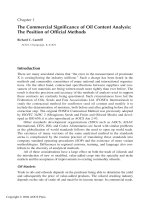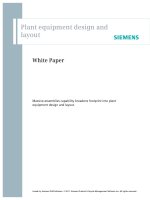Satellite networking principles and protocols phần 1 ppsx
Bạn đang xem bản rút gọn của tài liệu. Xem và tải ngay bản đầy đủ của tài liệu tại đây (567.12 KB, 38 trang )
Satellite Networking
Principles and Protocols
Zhili Sun
University of Surrey, UK
Satellite Networking
Satellite Networking
Principles and Protocols
Zhili Sun
University of Surrey, UK
Copyright © 2005 John Wiley & Sons Ltd, The Atrium, Southern Gate, Chichester,
West Sussex PO19 8SQ, England
Telephone (+44) 1243 779777
Email (for orders and customer service enquiries):
Visit our Home Page on www.wiley.com
All Rights Reserved. No part of this publication may be reproduced, stored in a retrieval system or
transmitted in any form or by any means, electronic, mechanical, photocopying, recording,
scanning or otherwise, except under the terms of the Copyright, Designs and Patents Act 1988 or
under the terms of a licence issued by the Copyright Licensing Agency Ltd, 90 Tottenham Court
Road, London W1T 4LP, UK, without the permission in writing of the Publisher. Requests to the
Publisher should be addressed to the Permissions Department, John Wiley & Sons Ltd, The Atrium,
Southern Gate, Chichester, West Sussex PO19 8SQ, England, or emailed to , or
faxed to (+44) 1243 770620.
Designations used by companies to distinguish their products are often claimed as trademarks.
All brand names and product names used in this book are trade names, service marks, trademarks or
registered trademarks of their respective owners. The Publisher is not associated with any
product or vendor mentioned in this book.
This publication is designed to provide accurate and authoritative information in regard to the subject
matter covered. It is sold on the understanding that the Publisher is not engaged in rendering
professional services. If professional advice or other expert assistance is required, the services of a
competent professional should be sought.
Other Wiley Editorial Offices
John Wiley & Sons Inc., 111 River Street, Hoboken, NJ 07030, USA
Jossey-Bass, 989 Market Street, San Francisco, CA 94103-1741, USA
Wiley-VCH Verlag GmbH, Boschstr. 12, D-69469 Weinheim, Germany
John Wiley & Sons Australia Ltd, 42 McDougall Street, Milton, Queensland 4064, Australia
John Wiley & Sons (Asia) Pte Ltd, 2 Clementi Loop #02-01, Jin Xing Distripark, Singapore 129809
John Wiley & Sons Canada Ltd, 22 Worcester Road, Etobicoke, Ontario, Canada M9W 1L1
Wiley also publishes its books in a variety of electronic formats. Some content that appears
in print may not be available in electronic books.
Library of Congress Cataloging in Publication Data
Sun, Zhili.
Satellite networking principles and protocols / Zhili Sun.
p. cm.
Includes bibliographical references.
ISBN-10: 0-470-87027-3
ISBN-13: 978-0-470-87027-3
1. Artificial satellites in telecommunication. 2. Computer network protocols.
3. Internetworking (Telecommunication) I. Title.
TK5104.S78 2005
621.382
5
028546—dc22
2005012260
British Library Cataloguing in Publication Data
A catalogue record for this book is available from the British Library
ISBN-13 978-0-470-87027-3 (HB)
ISBN-10 0-470-87027-3 (HB)
Typeset in 10/12pt Times by Integra Software Services Pvt. Ltd, Pondicherry, India.
Printed and bound in Great Britain by Antony Rowe Ltd, Chippenham, Wiltshire.
This book is printed on acid-free paper responsibly manufactured from sustainable forestry
in which at least two trees are planted for each one used for paper production.
This book is dedicated to the memory of my grandparents
To my parents
To my wife
Contents
List of Tables xix
List of Figures xxi
Preface xxvii
Acknowledgements xxxi
1 Introduction 1
1.1 Applications and services of satellite networks 1
1.1.1 Roles of satellite networks 2
1.1.2 Network software and hardware 4
1.1.3 Satellite network interfaces 4
1.1.4 Network services 5
1.1.5 Applications 5
1.2 ITU-R definitions of satellite services 5
1.2.1 Fixed satellite service (FSS) 5
1.2.2 Mobile satellite service (MSS) 6
1.2.3 Broadcasting satellite service (BSS) 6
1.2.4 Other satellite services 6
1.3 ITU-T definitions of network services 6
1.3.1 Interactive services 6
1.3.2 Distribution services 7
1.4 Internet services and applications 8
1.4.1 World wide web (WWW) 8
1.4.2 File transfer protocol (FTP) 9
1.4.3 Telnet 9
1.4.4 Electronic mail (email) 9
1.4.5 Multicast and content distribution 10
1.4.6 Voice over internet protocol (VoIP) 10
1.4.7 Domain name system (DNS) 10
1.5 Circuit-switching network 11
1.5.1 Connection set up 12
1.5.2 Signalling 12
viii Contents
1.5.3 Transmission multiplexing hierarchy based on FDM 13
1.5.4 Transmission multiplexing hierarchy based on TDM 13
1.5.5 Space switching and time switching 15
1.5.6 Coding gain of forward error correction (FEC) 16
1.6 Packet-switching networks 16
1.6.1 Connection-oriented approach 17
1.6.2 Connectionless approach 18
1.6.3 Relationship between circuit switching and packet switching 19
1.6.4 Impacts of packet on network designs 20
1.6.5 Packet header and payload 20
1.6.6 Complexity and heterogeneous networks 20
1.6.7 Performance of packet transmissions 21
1.6.8 Impact of bit level errors on packet level 21
1.7 OSI/ISO reference model 22
1.7.1 Protocol terminology 22
1.7.2 Layering principle 22
1.7.3 Functions of the seven layers 23
1.7.4 Fading of the OSI/ISO reference model 24
1.8 The ATM protocol reference model 24
1.8.1 Narrowband ISDN (N-ISDN) 24
1.8.2 Broadband ISDN (B-ISDN) 24
1.8.3 ATM technology 25
1.8.4 The reference model 25
1.8.5 Problems: lack of available services and applications 26
1.9 Internet protocols reference model 26
1.9.1 Network layer: IP protocol 27
1.9.2 Network technologies 27
1.9.3 Transport layer: TCP and UDP 27
1.9.4 Application layer 27
1.9.5 Problems: no QoS and no control on resources 27
1.10 Satellite network 28
1.10.1 Access network 28
1.10.2 Transit network 28
1.10.3 Broadcast network 28
1.10.4 Space segment 28
1.10.5 Ground segment 30
1.10.6 Satellite orbits 30
1.10.7 Satellite transmission frequency bands 31
1.11 Characteristics of satellite networks 32
1.11.1 Propagation delay 33
1.11.2 Propagation loss and power limited 33
1.11.3 Orbit space and bandwidth limited for coverage 34
1.11.4 Operational complexity for LEO 34
1.12 Channel capacity of digital transmissions 34
1.12.1 The Nyquist formula for noiseless channels 34
1.12.2 The Shannon theorem for noise channels 34
1.12.3 Channel capacity boundary 35
1.12.4 The Shannon power limit (−16 dB) 36
1.12.5 Shannon bandwidth efficiency for large E
b
/N
0
36
Contents ix
1.13 Internetworking with terrestrial networks 37
1.13.1 Repeaters at the physical layer 37
1.13.2 Bridges at link layer 37
1.13.3 Switches at the physical, link and network layers 37
1.13.4 Routers for interconnecting heterogeneous networks 38
1.13.5 Protocol translation, stacking and tunnelling 38
1.13.6 Quality of service (QoS) 39
1.13.7 End-user QoS class and requirements 39
1.13.8 Network performance 40
1.13.9 QoS and NP for satellite networking 40
1.14 Digital video broadcasting (DVB) 42
1.14.1 The DVB standards 42
1.14.2 DVB-S satellite delivery 43
1.14.3 MPEG-2 baseband processing 44
1.14.4 Transport stream (TS) 44
1.14.5 Service objectives 45
1.14.6 Satellite channel adaptation 45
1.14.7 DVB return channel over satellite (DVB-RCS) 46
1.14.8 TCP/IP over DVB 47
1.15 Historical development of computer and data networks 47
1.15.1 The dawn of the computer and data communications age 47
1.15.2 Development of local area networks (LANs) 47
1.15.3 Development of WANs and ISO/OSI 48
1.15.4 The birth of the Internet 48
1.15.5 Integration of telephony and data networks 48
1.15.6 Development of broadband integrated networks 48
1.15.7 The killer application WWW and Internet evolutions 49
1.16 Historical development of satellite communications 49
1.16.1 Start of satellite and space eras 49
1.16.2 Early satellite communications: TV and telephony 49
1.16.3 Development of satellite digital transmission 50
1.16.4 Development of direct-to-home (DTH) broadcast 50
1.16.5 Development of satellite maritime communications 50
1.16.6 Satellite communications in regions and countries 50
1.16.7 Satellite broadband networks and mobile networks 50
1.16.8 Internet over satellite networks 50
1.17 Convergence of network technologies and protocols 51
1.17.1 Convergence of services and applications in user terminals 51
1.17.2 Convergence of network technologies 52
1.17.3 Convergence of network protocols 52
1.17.4 Satellite network evolution 53
Further reading 53
Exercises 53
2 Satellite Orbits and Networking Concepts 55
2.1 Laws of physics 56
2.1.1 Kepler’s three laws 56
2.1.2 Newton’s three laws of motion and the universal law of gravity 56
2.1.3 Kepler’s first law: satellite orbits 57
2.1.4 Kepler’s second law: area swept by a satellite vector 59
x Contents
2.1.5 Kepler’s third law: orbit period 60
2.1.6 Satellite velocity 60
2.2 Satellite orbit parameters 61
2.2.1 Semi-major axis (a)61
2.2.2 Eccentricity (e)61
2.2.3 Inclination of orbit (i)62
2.2.4 Right ascension of the node () and argument of perigee ()63
2.3 Useful orbits 63
2.3.1 Geosynchronous earth orbits 63
2.3.2 Geostationary earth orbits (GEOs) 64
2.3.3 High elliptical orbits (HEOs) 64
2.3.4 Notations of low earth orbit (LEO) satellite constellations 65
2.3.5 Orbital perturbations 66
2.3.6 Satellite altitude and coverage 66
2.3.7 Antenna gain and beam-width angle 67
2.3.8 Coverage calculations 67
2.3.9 Distance and propagation delay from earth station to satellite 68
2.4 Satellite link characteristics and modulations for transmissions 69
2.4.1 Satellite link characteristics 71
2.4.2 Modulation techniques 71
2.4.3 Phase shift keying (PSK) schemes for satellite transmissions 72
2.4.4 Binary phase shift keying (BPSK) 73
2.4.5 Quadrature PSK (QPSK) 73
2.4.6 Gaussian-filtered minimum shift keying (GMSK) 74
2.4.7 Bit error rate (BER): the quality parameter of modulation schemes 75
2.4.8 Satellite networking in the physical layer 75
2.5 Forward error correction (FEC) 77
2.5.1 Linear block codes 78
2.5.2 Cyclic codes 78
2.5.3 Trellis coding and convolutional codes 79
2.5.4 Concatenated codes 79
2.5.5 Turbo codes 80
2.5.6 Performance of FEC 81
2.6 Multiple access techniques 81
2.6.1 Frequency division multiple access (FDMA) 83
2.6.2 Time division multiple access (TDMA) 83
2.6.3 Code division multiple access (CDMA) 84
2.6.4 Comparison of FDMA, TDMA and CDMA 84
2.7 Bandwidth allocation 84
2.7.1 Fixed assignment access 85
2.7.2 Demand assignment 85
2.7.3 Random access 86
2.8 Satellite networking issues 86
2.8.1 Single hop satellite connections 86
2.8.2 Multi-hop satellite connections 86
2.8.3 Inter-satellite links (ISL) 88
2.8.4 Handovers 89
2.8.5 Satellite intra-beam and inter-beam handovers 90
2.8.6 Earth fixed coverage vs. satellite fixed coverage 91
2.8.7 Routing within constellation of satellites network 92
Contents xi
2.8.8 Internetworking 92
2.8.9 Satellite availability and diversity 93
Further reading 94
Exercises 94
3 ATM and Internet Protocols 97
3.1 ATM protocol and fundamental concepts 97
3.1.1 Packetisation delay 99
3.1.2 Queuing delay 99
3.1.3 Compromise solution between North America and Europe 100
3.2 ATM layer 101
3.2.1 The GFC field 101
3.2.2 The VPI and VCI fields 101
3.2.3 The CLP field 103
3.2.4 The PT field 104
3.2.5 The HEC field 104
3.3 ATM adaptation layer (AAL) 104
3.3.1 AAL1 for class A 105
3.3.2 AAL2 for class B 107
3.3.3 AAL3/4 for classes C and D 107
3.3.4 AAL5 for Internet protocol 107
3.4 The physical layer 109
3.4.1 The physical medium (PM) sublayers 109
3.4.2 The transmission convergence (TC) sublayer 109
3.4.3 ATM cell transmissions 110
3.4.4 Target solution for ATM transmission 110
3.4.5 ATM over synchronous digital hierarchy (SDH) 110
3.4.6 ATM over DS1 112
3.4.7 ATM over E1 113
3.5 ATM interfaces and ATM networking 113
3.5.1 User–network access 113
3.5.2 Network node interconnections 114
3.5.3 ATM DXI 115
3.5.4 B-ICI 116
3.5.5 Permanent virtual connections vs. switched virtual connections 116
3.5.6 ATM signalling 117
3.5.7 ATM addressing 117
3.5.8 Address registration 118
3.6 Network traffic, QoS and performance issues 119
3.6.1 Traffic descriptors 120
3.6.2 Quality of service (QoS) parameters 120
3.6.3 Performance issues 120
3.7 Network resource management 121
3.7.1 Connection admission control (CAC) 122
3.7.2 UPC and NPC 122
3.7.3 Priority control and congestion control 122
3.7.4 Traffic shaping 123
3.7.5 Generic cell rate algorithm (GCRA) 123
3.7.6 Leaky bucket algorithm (LBA) 123
3.7.7 Virtual scheduling algorithm (VSA) 126
xii Contents
3.8 Internet protocols 127
3.8.1 Internet networking basics 127
3.8.2 Protocol hierarchies 128
3.8.3 Connectionless network layer 128
3.8.4 The IP packet format 128
3.8.5 IP address 130
3.8.6 Mapping between Internet and physical network addresses 131
3.8.7 ARP and RARP 132
3.8.8 Internet routing protocols 132
3.8.9 The interior gateway routing protocol (IGRP) 132
3.8.10 The exterior gateway routing protocol (EGRP) 133
3.9 Transport layer protocols: TCP and UDP 133
3.9.1 Transmission control protocol (TCP) 133
3.9.2 The TCP segment header format 134
3.9.3 Connection set up and data transmission 135
3.9.4 Congestion and flow control 136
3.9.5 User datagram protocol (UDP) 137
3.10 IP and ATM internetworking 138
3.10.1 LAN emulation (LANE) 139
3.10.2 LANE components 140
3.10.3 LANE entity communications 140
3.10.4 Classical IP over ATM 141
3.10.5 Packet encapsulation 141
3.10.6 IP and ATM address resolution 142
Further reading 143
Exercises 144
4 Satellite Internetworking with Terrestrial Networks 145
4.1 Networking concepts 145
4.2 Networking terminology 147
4.2.1 Private network 147
4.2.2 Public network 147
4.2.3 Quality aspects of telephony services 148
4.2.4 IP based network 148
4.3 Network elements and connections 149
4.3.1 Network terminals 149
4.3.2 Network nodes 150
4.3.3 Network connections 150
4.3.4 End-to-end connections 151
4.3.5 Reference configurations 151
4.4 Network traffic and signalling 152
4.4.1 User traffic and network services 152
4.4.2 Signalling systems and signalling traffic 154
4.4.3 In-band signalling 154
4.4.4 Out-of-band signalling 155
4.4.5 Associated and disassociated channel signalling 156
4.4.6 ITU-T signalling system No. 7 (ITU-T SS7) 156
4.4.7 Network management 158
4.4.8 Network operation systems and mediation functions 158
Contents xiii
4.5 Access and transit transmission networks 160
4.5.1 Analogue telephony networks 160
4.5.2 Telephony network traffic engineering concept 161
4.5.3 Access to satellite networks in the frequency domain 162
4.5.4 On-board circuit switching 162
4.6 Digital telephony networks 163
4.6.1 Digital multiplexing hierarchy 163
4.6.2 Satellite digital transmission and on-board switching 164
4.6.3 Plesiochronous digital hierarchy (PDH) 165
4.6.4 Limitations of the PDH 165
4.7 Synchronous digital hierarchy (SDH) 166
4.7.1 Development of SDH 167
4.7.2 The SDH standards 167
4.7.3 Mapping from PDH to SDH 168
4.7.4 The benefits of SDH 169
4.7.5 Synchronous operation 169
4.7.6 Synchronous optical network (SONET) 171
4.7.7 SDH over satellite – the Intelsat scenarios 171
4.8 Integrated services digital networks (ISDN) 173
4.8.1 Basic rate interface (BRI) 173
4.8.2 Primary rate interface (PRI) 174
4.8.3 ISDN physical layer (layer 1) 175
4.8.4 ISDN link layer (layer 2) 176
4.8.5 ISDN network layer (layer 3) 176
4.9 ISDN over satellite 177
4.9.1 ITU-T ISDN hypothetical reference connection (IRX) 177
4.9.2 ITU-R hypothetical reference digital path (HRDP) for satellite 178
4.9.3 Performance objectives 179
4.9.4 Satellite network to ISDN interconnection scenarios 179
4.9.5 Routing plan 180
4.10 Interworking with heterogeneous networks 183
4.10.1 Services 184
4.10.2 Addressing 184
4.10.3 Routing 184
4.10.4 Evolution 185
Further reading 185
Exercises 186
5 ATM over Satellite Networks 187
5.1 Background 187
5.1.1 Networking issues 188
5.1.2 Satellite services in the B-ISDN networking environment 188
5.2 Design issues of satellite ATM systems 190
5.2.1 Propagation delay 190
5.2.2 Attenuation and constraints 191
5.3 The GEO satellite ATM networking architecture 192
5.3.1 The ground segment 192
5.3.2 The space segment 193
5.3.3 Satellite bandwidth resource management 194
5.3.4 Connection admission control (CAC) 195
xiv Contents
5.3.5 Network policing functions 195
5.3.6 Reactive congestion control 196
5.4 Advanced satellite ATM networks 196
5.4.1 Radio access layer 197
5.4.2 On-board processing (OBP) characteristics 197
5.4.3 The ATM on-board switch 198
5.4.4 Multibeam satellites 199
5.4.5 LEO/MEO satellite constellations 201
5.4.6 Inter-satellite links (ISL) 201
5.4.7 Mobile ATM 202
5.4.8 Use of higher frequency spectrum 202
5.5 ATM performance 203
5.5.1 Layered model of performance for B-ISDN 203
5.5.2 ATM performance parameters 203
5.5.3 Impact of satellite burst errors on the ATM layer 205
5.5.4 Impact of burst errors on AAL protocols 207
5.5.5 Error control mechanisms 208
5.5.6 Enhancement techniques for satellite ATM networks 209
5.6 Evolution of ATM satellite systems 210
Further reading 212
Exercises 212
6 Internet Protocol (IP) over Satellite Networks 213
6.1 Different viewpoints of satellite networking 213
6.1.1 Protocol-centric viewpoint of satellite IP network 214
6.1.2 Satellite-centric viewpoint of global networks and the Internet 215
6.1.3 Network-centric viewpoint of satellite networks 216
6.2 IP packet encapsulation 217
6.2.1 Basic concepts 217
6.2.2 High-level data link control (HDLC) protocol 217
6.2.3 Point-to-point protocol (PPP) 218
6.2.4 Media access control 219
6.2.5 IP over satellite 219
6.3 Satellite IP networking 219
6.3.1 Routing on board satellites 221
6.3.2 IP mobility in satellite networks 221
6.3.3 Address resolution 223
6.4 IP multicast over satellite 223
6.4.1 IP multicast 223
6.4.2 IP multicast addressing 225
6.4.3 Multicast group management 225
6.4.4 IP multicast routing 225
6.4.5 IP multicast scope 227
6.4.6 IGMP behaviour in satellite environments 227
6.4.7 Multicast routing protocols in a satellite environment 228
6.4.8 Reliable multicast protocols over satellites 230
6.5 Basic network security mechanisms 231
6.5.1 Security approaches 231
6.5.2 Single-direction hashing functions 231
6.5.3 Symmetrical codes (with secret keys) 232
6.5.4 Asymmetrical codes (with public/private keys) 232
Contents xv
6.6 Satellite networking security 234
6.6.1 IP security (IPsec) 234
6.6.2 Satellite VPN 235
6.6.3 IP multicast security 235
6.7 DVB over satellite 236
6.7.1 MPEG-2 source coding and multiplexing DVB-S streams 237
6.7.2 DVB over satellite (DVB-S) 238
6.7.3 DVB security 239
6.7.4 Conditional access in DVB-S 240
6.7.5 DVB-RCS interactive service and IP over DVB 241
6.7.6 DVB-RCS security 242
6.7.7 DVB security and IP multicast security 243
6.8 Internet quality of service (IP QoS) 243
6.8.1 Layered model of performance for IP service 244
6.8.2 IP packet transfer performance parameters 245
6.8.3 IP network performance objectives for QoS classes 246
6.8.4 Guidance on IP QoS class usage 247
6.9 Integrated services (Intserv) architectures for QoS 247
6.9.1 Integrated services architecture (ISA) principles 248
6.9.2 The resource reservation protocol (RSVP) 249
6.9.3 Intserv service classes 251
6.10 Differentiated services (Diffserv) for QoS 251
6.10.1 DSA principles 252
6.10.2 Traffic classification 253
6.10.3 Traffic conditioning 254
6.10.4 Diffserv per hop behaviour (PHB) 254
6.10.5 Supporting Intserv across the satellite network Diffserv domain 256
Further reading 258
Exercises 258
7 Impact of Satellite Networks on Transport Layer Protocols 261
7.1 Introduction 262
7.1.1 Application characteristics 262
7.1.2 Client and server host parameters 263
7.1.3 Satellite network configurations 263
7.1.4 TCP and satellite channel characteristics 264
7.1.5 TCP flow control, congestion control and error recovery 265
7.2 TCP performance analysis 266
7.2.1 First TCP segment transmission 267
7.2.2 TCP transmission in the slow-start stage 267
7.2.3 TCP transmission in congestion avoidance stage 268
7.3 Slow-start enhancement for satellite networks 269
7.3.1 TCP for transactions 270
7.3.2 Slow start and delayed acknowledgement (ACK) 270
7.3.3 Larger initial window 271
7.3.4 Terminating slow start 271
7.4 Loss recovery enhancement 272
7.4.1 Fast retransmission and fast recovery 272
7.4.2 Selective acknowledgement (SACK) 273
7.4.3 SACK based enhancement mechanisms 273
xvi Contents
7.4.4 ACK congestion control 274
7.4.5 ACK filtering 274
7.4.6 Explicit congestion notification 275
7.4.7 Detecting corruption loss 276
7.4.8 Congestion avoidance enhancement 276
7.5 Enhancements for satellite networks using interruptive mechanisms 277
7.5.1 TCP spoofing 278
7.5.2 Cascading TCP or split TCP 278
7.5.3 The perfect TCP solution for satellite networking 279
7.6 Impacts on applications 279
7.6.1 Bulk transfer protocols 279
7.6.2 Semi-interactive protocols 280
7.6.3 Interactive protocols 280
7.6.4 Distributed methods for providing Internet services and applications 281
7.6.5 Web caching in satellite networks 282
7.7 Real-time transport protocol (RTP) 283
7.7.1 Basics of RTP 283
7.7.2 RTP control protocol (RTCP) 285
7.7.3 Sender report (SR) packets 286
7.7.4 Receiver report (RR) packets 288
7.7.5 Source description (SDES) RTCP packet 288
7.7.6 SAP and SIP protocols for session initiations 288
7.7.7 Session directory service (SDS) 290
7.8 Voice over IP 291
7.8.1 Gateway decomposition 291
7.8.2 Protocols 291
7.8.3 Gatekeepers 291
7.8.4 Multimedia conferencing (MMC) 291
7.8.5 Conference control 292
Further reading 292
Exercises 293
8 Next Generation Internet (NGI) over Satellite 295
8.1 Introduction 296
8.2 New services and applications 296
8.2.1 Internet integrated services 296
8.2.2 Elastic and inelastic traffic 297
8.2.3 QoS provision and network performance 298
8.3 Traffic modelling and characterisation 298
8.3.1 Traffic modelling techniques 299
8.3.2 Scope of traffic modelling 299
8.3.3 Statistical methods for traffic modelling 300
8.3.4 Renewal traffic models 300
8.3.5 Markov models 300
8.3.6 Fluid traffic models 301
8.3.7 Auto-regressive and moving average traffic models 301
8.3.8 Self-similar traffic models 302
8.4 The nature of internet traffic 302
8.4.1 The world wide web (WWW) 302
8.4.2 Pareto distribution model for self-similar traffic 304
Contents xvii
8.4.3 Fractional Brownian motion (FBM) process 304
8.4.4 Consideration of user behaviour in traffic modelling 305
8.4.5 Voice traffic modelling 306
8.4.6 On-off model for voice traffic 308
8.4.7 Video traffic modelling 309
8.4.8 Multi-layer modelling for internet WWW traffic 311
8.5 Traffic engineering 312
8.5.1 Traffic engineering principles 312
8.5.2 Internet traffic engineering 314
8.6 Multi-protocol label switching (MPLS) 316
8.6.1 MPLS forwarding paradigm 316
8.6.2 MPLS basic operation 318
8.6.3 MPLS and Diffserv interworking 321
8.6.4 MPLS and ATM interworking 322
8.6.5 MPLS with traffic engineering (MPLS-TE) 323
8.7 Internet protocol version 6 (IPv6) 324
8.7.1 Basics of internet protocol version 6 (IPv6) 324
8.7.2 IPv6 addressing 326
8.7.3 IPv6 networks over satellites 329
8.7.4 IPv6 transitions 329
8.7.5 IPv6 tunnelling through satellite networks 330
8.7.6 The 6to4 translation via satellite networks 330
8.7.7 Issues with 6to4 332
8.7.8 Future development of satellite networking 332
Further reading 334
Exercises 335
Index 337
List of Tables
1.1 Typical frequency bands of satellite communications 32
1.2 Example usages of frequency bands for GEO 33
2.1 Modulation methods 76
2.2 Cyclic redundancy check (CRC) code 79
2.3 Comparison of main multiple access method properties 85
3.1 Option fields of the IPv4 packet header 130
4.1 Quality objectives for digital telephony and 64 kbit/s ISDN 179
4.2 Overall end-to-end and satellite HRDP error performance objectives for international
ISDN connections 180
4.3 Overall end-to-end and satellite HRDP error performance objectives for digital
connection at primary rate or above 181
5.1 Comparison of various switching techniques 200
6.1 Provisional IP network QoS class definitions and network performance objectives
(Y.1540) (Reproduced with the kind permission of ITU) 246
6.2 Guidance for IP QoS classes (Y.1541) (Reproduced with the kind permission of ITU) 247
8.1 Parameters for G.711, G.729, G.723.1 and G.726 codecs 307
8.2 Network delay specifications for voice applications (ITU-T, G114) 308
8.3 LSP attributes 319
8.4 IPv6 extension headers 326
8.5 Some reserved multicast addresses 328
8.6 IPv6 addressing architecture 328
List of Figures
1.1 Typical applications and services of satellite networking 2
1.2 Functional relationships of user terminal, terrestrial network and satellite network 3
1.3 Typical topologies of networks: star, hierarchy and mesh 11
1.4 Circuit switching networks 11
1.5 Concept of multiplexing in the frequency domain 13
1.6 Analogue transmission multiplexing hierarchy 14
1.7 Concept of multiplexing in the time domain 14
1.8 Digital transmission hierarchies 15
1.9 Space switching concept 15
1.10 Time switching concept 16
1.11 Virtual channel switching concept 18
1.12 Datagram routing concept 19
1.13 Packet error probabilities for given bit error probabilities and packet sizes 21
1.14 OSI/ISO seven-layer reference model 23
1.15 B-ISDN ATM reference model 25
1.16 The Internet reference model 26
1.17 Illustration of the space segment and ground segment 29
1.18 Satellite orbits 31
1.19 Attenuations of different frequency band due to A: rain, B: fog and C: gas 32
1.20 Capacity boundary of communication channel 35
1.21 The Shannon bandwidth efficiency for large E
b
/N
0
36
1.22 Using routers to internetwork with heterogeneous terrestrial networks 38
1.23 Mapping of user-centric QoS requirements into network performance (ITUT-G1010)
(Reproduced with the kind permission of ITU.) 39
1.24 Model for user-centric QoS categories (ITU-T-G1010) (Reproduced with the kind
permission of ITU.) 40
1.25 The four viewpoints of QoS (ITU-T-G1000) (Reproduced with the kind permission
of ITU.) 41
1.26 User- and network-centric views of QoS and NP concepts 41
1.27 Satellite in the global information infrastructure 51
2.1 Vector from earth to satellite 57
2.2 Orbit with major axis of orbit (AB) and semi-major axis of orbit (AO)59
2.3 Inclination of orbit, I 62
2.4 Equatorial, incline and polar orbits 62
2.5 Right Ascension of the node and argument of perigee 63
2.6 Footprints of geosynchronous satellites 64
2.7 A typical high elliptical orbit 65
xxii List of Figures
2.8 Footprint of a LEO satellite 65
2.9 Relationships between altitude and coverage 66
2.10 Antenna radiation pattern 67
2.11 Relation between elevation angle and altitude 68
2.12 Distance between earth station and satellite 69
2.13 Carrier waves, modulating signals and modulated signals 70
2.14 Signal-space diagram for coherent BPSK 73
2.15 Signal-space diagram for coherent QPSK 74
2.16 Noise performance of modulation schemes 76
2.17 Block diagram of physical layer functions of satellite networks 77
2.18 Forward error correction (FEC) coding 77
2.19 Block diagram of turbo encoder 80
2.20 Block diagram of turbo decoder 81
2.21 Comparison of FEC codes 82
2.22 Multiple access techniques: FDMA, TDMA and CDMA 82
2.23 Comparison between the concepts of multiplexing and multiple access 82
2.24 A typical example of satellite TDMA scheme 83
2.25 Single hop topology with satellite at the centre 87
2.26 Multiple hops topology with hub at the centre 87
2.27 Satellite networks with inter-satellite links 88
2.28 Concepts of inter-satellite beam and intra-satellite beam handovers 89
2.29 Satellite constellations of earth fixed coverage and satellite fixed coverage 91
2.30 Satellite network availability model 93
3.1 ATM cell 98
3.2 Functions of the ATM protocol stack 98
3.3 Trade-off between delay and cell payload efficiency 99
3.4 Delay due to packetisation and queuing 100
3.5 The ATM cell header format at the UNI and NNI 101
3.6 Connection/routing table in ATM switch 102
3.7 Concept of VP and VC in physical layer 102
3.8 Example of VP switching 103
3.9 Example of VC and VP switching 103
3.10 Service classes and their attributes 105
3.11 AAL 1 packet format for Class A 105
3.12 Illustration of adaptive clock method 106
3.13 AAL 2 packet format for Class B 107
3.14 AAL 3/4 packet format for ClassesC&D 108
3.15 AAL 5 format for Internet protocol 108
3.16 The ITU-T target solution for ATM cell transmission 110
3.17 SDH STM-1 frame 111
3.18 DS1 frame structure of 1.544 Mbit/s 112
3.19 E1 frame structure of 2.048 Mbit/s 113
3.20 B-ISDN reference configuration 114
3.21 ATM interfaces network nodes interconnections 115
3.22 ATM address format 118
3.23 Generic cell rate (GCRA) algorithm 124
3.24 Leaky bucket algorithm (LBA) 124
3.25 An illustration of smooth traffic coming to the leaky bucket - GCRA(1.5, 0.5) 125
3.26 Illustration of burst traffic coming to the leaky bucket - GCRA(4.5, 7) 126
3.27 Virtual scheduling algorithm (VSA) 126









